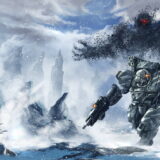 Dotted with portholes, an enormous red vessel looms over a shoreline. Nearby, a crowd of people gather around a seaside wall, throwing their arms into the air in panic as spurts of water break through the bulwark. In terms of shape, the vessel resembles the alleged flying saucers photographed by George Adamski in the 1950s. But this was November 1926, and the phrase “flying saucer” would have meant nothing to readers of Amazing Stories. Instead, the craft depicted on the cover was a modernisation of one of the oldest vessels in speculative fiction: Noah’s Ark.
Dotted with portholes, an enormous red vessel looms over a shoreline. Nearby, a crowd of people gather around a seaside wall, throwing their arms into the air in panic as spurts of water break through the bulwark. In terms of shape, the vessel resembles the alleged flying saucers photographed by George Adamski in the 1950s. But this was November 1926, and the phrase “flying saucer” would have meant nothing to readers of Amazing Stories. Instead, the craft depicted on the cover was a modernisation of one of the oldest vessels in speculative fiction: Noah’s Ark.
In this month’s editorial, Hugo Gernsback publishes a letter from one W. F. Crist, criticising some of Amazing’s stories: “some of the stories have such obvious scientific mistakes in them,’ writes Crist, “that they seem more like fairy tales than scientifiction”. The main targets of the letter are the inconsistent portrayal of time-reversal in Murray Leinster’s “The Runaway Skyscraper” and any stories of interplanetary travel that do not take into account the hazards posed by alien bacteria. Gernsback responds by, once again, pleading artistic license.
Scientifically plausible or not, the magazine had another crop of amazing stories for readers of 1926…
The Second Deluge by Garrett P. Serviss (part 1 of 4)
 This story, originally serialised in The Cavalier between 1911 and 1912, introduces us to Cosmo Versál, an astronomer of gnome-like appearance who would fit right alongside Jules Verne’s eccentric protagonists. He makes the startling discovery that Earth is about to pass through a watery nebula, which will lead to catastrophic flooding:
This story, originally serialised in The Cavalier between 1911 and 1912, introduces us to Cosmo Versál, an astronomer of gnome-like appearance who would fit right alongside Jules Verne’s eccentric protagonists. He makes the startling discovery that Earth is about to pass through a watery nebula, which will lead to catastrophic flooding:
“My God!” He said. “That’s it! That Lick photograph of the Lord Rosse Nebula is its very image, except that there’s no electric fire in it. The same great whirl of outer spirals, and then comes the awful central mass—and we’re going to plunge straight into it. Then quintillions of tons of water will condense on the earth and cover it like a universal cloudburst. And then good-by to the human race—unless—unless—I, Cosmo Versál, inspired by science, can save a remnant to repeople the planet after the catastrophe.”
At first, the public scoffs at Versál’s warnings, with some even condemning him as a false prophet or Antichrist. But the fact is that only he can save humanity, by acting as a new Noah and building an ark.
As the outbreak of the flood approaches, the novel’s whimsical tone gives way to a feeling of dread, although not without losing its satirical bite. Versál must make the grave decision as to exactly what fraction of humanity he allows to survive on his ark; he rejects race as a point of consideration (“I shall not look to see whether a man is black, white, or yellow”) but does take “the principles of eugenics” into account, insisting that each couple should be allowed no more than two children so as to ensure broad range of families.
Versál assembles a list of the people he feels are best suited to rebuilding civilisation. Scientists, mechanics and farmers are the best-represented groups; also included are doctors, religious teachers, two magazine editors (“No world could get along without some real idiots”), actors and musicians to provide entertainment (the latter are chosen according to how easily Versál can pronounce their names) and a single lawyer. Monarchs, presidents and other world leaders turn up in the discussion as well; the present Kaiser makes the cut (“he has at last got the war microbe out of the family blood”) but Versál decides against perpetuating the Romanov dynasty.
When it comes to animals, Versál is more discriminating than his forbear Noah. He saves only the animals that will be useful to society and ecology, including the various weird and wonderful forms of livestock that have been bred into existence in this future.
Meanwhile, as the flood sets in, the public that once scoffed at Versál is now beating on the hatches of his ark…
All in all, a much sharper piece of speculative fiction than the lumpen A Columbus of Space, the previous Serviss novel to be serialised in Amazing.
“The Mad Planet” by Murray Leinster
 Originally published in Argosy in 1920, “The Mad Planet” is a post-apocalyptic story. It takes place on an Earth that has been devastated by climate change, as a result of carbon dioxide escaping into the atmosphere through fissures in the planet’s crust. Humanity survived, but only barely: thirty thousand years alter civilisation has collapsed, society has regressed to a pre-stone age level.
Originally published in Argosy in 1920, “The Mad Planet” is a post-apocalyptic story. It takes place on an Earth that has been devastated by climate change, as a result of carbon dioxide escaping into the atmosphere through fissures in the planet’s crust. Humanity survived, but only barely: thirty thousand years alter civilisation has collapsed, society has regressed to a pre-stone age level.
The main character is Buri, a hunter-gatherer in this strange new world of the future. He makes his way through forests of enormous fir, and does battle against various colossal arthropods. The giant butterflies are harmless enough, but the giant spiders pose a much larger threat.
But Burl is “an atavism, a throwback to ancestors who had cultivated the earth and subjugated its animals.” He rediscovers the forgotten concept of weaponry: finding the body of a giant minotaur beetle, he takes its horn and uses this as a spear, both as a means of self-defence from predators and as a tool for hunting. He learns how to spear fish, and from there, discovers that the oil from the fish will protect him from the sticky webs of the giant spiders. He creates a second weapon by converting an ant’s leg into a club, and also finds time to invent clothing, turning a moth’s wing into a cape. Just the thing to impress his love, Saya, once the two are reunited following Burl’s expedition.
As Argosy was a sister title to All-Story, the original home to Tarzan, its readers may well have been familiar with the subject matter of “The Mad Planet”. But while Murray Leinster offers the same kind of man-versus-beast derring-do as Edgar Rice Burroughs (albeit on a smaller scale) he frames it as a serious-minded exploration into both the development of a drastically-altered Earth, and the intellectual development of early man. It works fairly well on each level, although the action-adventure aspect is ultimately the most successful.
“A Drama in the Air” by Jules Verne
 Here we have a little-known story by Jules Verne that was originally published in 1851 as “La science en famille. Un voyage en ballon”. Amazing’s introduction apologises for the story not being up to Verne’s later standards but argues that it is still of interest, pointing out that the plot “is not only probable, but in a newspaper account some years ago, the identical thing happened in a slightly different setting.”
Here we have a little-known story by Jules Verne that was originally published in 1851 as “La science en famille. Un voyage en ballon”. Amazing’s introduction apologises for the story not being up to Verne’s later standards but argues that it is still of interest, pointing out that the plot “is not only probable, but in a newspaper account some years ago, the identical thing happened in a slightly different setting.”
The story begins with a hot-air balloonist preparing to set off on an airborne trip. His companions drop out of the endeavour at the last minute, and so he is forced to go it alone. Or, at least, he thinks that he is alone until he finds a stowaway within his basket after taking to the skies.
The stranger turns out to be something of an armchair expert on the history of ballooning, and gushes at length about the history of the pursuit and its most illustrious practitioners. The balloonist wants to return to land – but the stowaway insists on going both higher and further, so as to break previous records.
The story begins as a comedy, pitting the increasingly flustered aeronaut against the affable stowaway. It then turns a darker corner when the main character starts to fear for his life at the hands of his unhinged fellow traveller, who rattles off lists of ballooning tragedies.
Is “A Drama in the Air” science fiction? It is fiction about the science of aeronautics, granted, but hot air ballooning was nothing new in 18XX (let alone 1926). The stowaway briefly discusses his extravagant vision of the future of flight, but this is only a small part of the narrative. It appears that the story was selected for Amazing mainly because of its authorship.
That said, when “A Drama in the Air” is read in the context of science fiction, it is amusing to note just how fannish the stowaway character is. He is obsessed with anecdotes about his various heroes, which he cannt help himself from recounting at length. By introducing himself as “Erostratus or Empedocles”, he even prefigures usage of online pseudonyms. Jules Verne created one of the earliest fanboys in all of SF.
“Beyond the Pole” by A. Hyatt Verrill (part 2 of 2)
 This conclusion to A. Hyatt Verrill’s story sees the protagonist continuing to live amongst a race of sapient crustaceans that is secluded near the South Pole. He learns that the species lives in a communist society, and has seen no struggles for possessions or resources. The downside to this is that the crustaceans practice extreme social engineering, destroying all surplus eggs and euthanising any member of their kind who is found to have been injured. On a more insidious level their lack of conflict has robbed their society of any goals; as a result, they live an emotionless, machine-like existence. The protagonist argues that this would be the inevitable result of socialism in the human world, as well.
This conclusion to A. Hyatt Verrill’s story sees the protagonist continuing to live amongst a race of sapient crustaceans that is secluded near the South Pole. He learns that the species lives in a communist society, and has seen no struggles for possessions or resources. The downside to this is that the crustaceans practice extreme social engineering, destroying all surplus eggs and euthanising any member of their kind who is found to have been injured. On a more insidious level their lack of conflict has robbed their society of any goals; as a result, they live an emotionless, machine-like existence. The protagonist argues that this would be the inevitable result of socialism in the human world, as well.
While the crustaceans have built advanced aircraft for themselves, the main character is surprised to find that they have neither steam engines nor the wheel. He builds an engine by way of demonstration, and the crustaceans reveal that they had, in fact, once made use of this invention – but so long ago that its very existence has passed into legend.
As established in the first instalment, the crustaceans are not the only unusual lifeforms in this shut-off region. Amongst the local fauna is a species of giant ant, which the crustaceans keep in captivity. This turns out to be their downfall: they find too late that the ants have been making vast burrows for themselves, creating an infestation poised to reach the surface. When the ants attack, the crustaceans are forced to return to the seas from whence they came. The human protagonist plans to flee back to the human world, but his fate is left ambiguous.
Like the first instalment, the latter half of this story is short on plot but heavy on speculation.
The Island of Doctor Moreau by H. G. Wells (part 2 of 2)
 The serialisation of Wells’ novel reaches its conclusion, and like the society of sapient crustaceans elsewhere in the issue, the society of animal-people created by Dr. Moreau is an ultimate failure. First, although the beast men are sworn not to eat flesh, one develops a taste for blood. It is not long before Dr. Moreau is killed by his own creation; protagonist Prendick tries to keep the beast men under control by convincing them that Moreau is still watching them as a discarnate deity, but they soon begin regressing to a bestial state.
The serialisation of Wells’ novel reaches its conclusion, and like the society of sapient crustaceans elsewhere in the issue, the society of animal-people created by Dr. Moreau is an ultimate failure. First, although the beast men are sworn not to eat flesh, one develops a taste for blood. It is not long before Dr. Moreau is killed by his own creation; protagonist Prendick tries to keep the beast men under control by convincing them that Moreau is still watching them as a discarnate deity, but they soon begin regressing to a bestial state.
Prendick escapes the island, only to find that urban humanity reminds him of the beast men back on the island. His only escape is to retreat into a secluded life of spiritual contemplation.
Hugo Gernsback is remembered as a champion of optimistic science fiction, but Amazing ran its share of darker-toned SF. The Island of Doctor Moreau is one of the most macabre to appear in its pages.
And Finally…
The November 1926 issue of Amazing Stories is a generally downbeat one, the dominant theme being societal collapse – either on a global scale, or within isolated communities. But it is not all doom and disaster. Rounding off the issue is another poem by Leland S. Copeland, entitled “Stars”:
Out through space my spirit leaps,
Swifter far than light;
Up to the lunar craters,
Gilded, banked with night;
Over the channeled, ruddy Mars,
Up through Saturn’s rings;
Parting the hair of comets,
On my spirit wings;
Out where vast and awful voids
Space the Milky Way—
Room for earths by hundreds
To spin the night and day;
Straight through stuff of orbs unborn,
Mammoth nebulae;
Lost where stars by thousands
Light the Ether Sea;
Far in timeless, bournless space
Till systems cease to roll;
Ever vainly seeking
Hope and the Supersoul
Millions die who never knew
Half I see and ken
While I circle madly
Through the stars. And then—
Back to earth my spirit falls,
Tired of cosmic dust;
Needing a human being,
Human love and trust;
Gliding down on fancy’s wings
Deep among the hills,
Where the elms and maples
Arch the flowered rills;
Back to dark-haired Mirabel
All my being flies;
Back to a wide-arm welcome
And the cosmos of her eyes.










